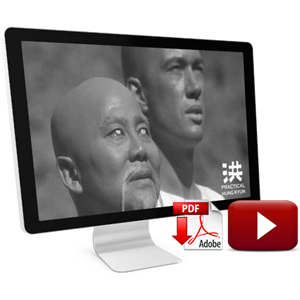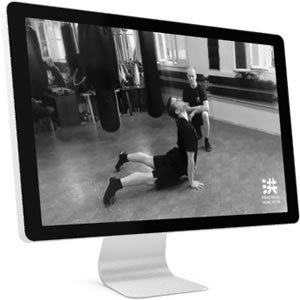This is part of my continuing series of articles discussing the practical training and application of Chinese martial arts. While their intent is not to insult, they are indeed intended to make the reader reexamine what they practice and how they practice it.

All technique exists in a context. Theory produces concepts, concepts produce techniques. However, all technique is based upon context. The theory and concepts instead are universal. The theory and concept persist. If we focus on the technique, ignoring the context, and ignore the theory and concepts, we do a disservice to our arts. This I believe is one of the major issues facing Chinese martial arts in the modern age.
By the time I moved to Washington DC in 1991 to pursue my graduate degree, Chan Tai-San’s school had already abandoned the so called “point fighting” that was offered in martial arts tournaments. We not only were limited in what we could do but we were consistently being disqualified not only for excessive contact but what the referees were calling “uncontrolled technique.” Lama Paai and Choi Lei Fat are both long arm systems, our techniques were not “uncontrolled” they were just something the so called officials were either uncomfortable or unfamiliar with.
The school had already begun participating in the national tournaments held by the North American Chinese Martial Arts Federation (NACMAF) under Tai Yim Sifu (Hung Fat). NACMAF sparring had no head contact, but was full contact to the body and legs. Our results were mixed. I placed third in the “open weight” division, disqualified for throwing a Sou Cheui (sweep punch) which did not actually connect. We had been told that was legal (to demonstrate the technique) but when I did I was disqualified. I still faired better than my training brother, Michael Parrella, who in his first match instinctively caught a kick and sweep out the supporting leg. Michael was immediately disqualified. That year we took as many trophies in sparring as we did in empty hand and weapon sets (see the picture below).

Prior to studying with Chan Tai San, I already had a background in amateur boxing and in full contact Taekwondo. We always had a generous amount of contact and sparring in the public classes I ran. The NACMAF sparring was better than most of the options we had at the time, but I still felt much was missing. In Washington DC, I worked out with a Jeet Kune Do group that mixed Joe Lewis’ Karate/Kickboxing system (with a strong boxing base) with Muay Thai. The UFC also premiered during the time I was in Washington DC. Upon returning to New York, I was interested in seeing how Lama Paai would hold up on different fighting events.
In the early years, we entered literally anything we could find. Each venue provided me with different challenges. Amateur boxing (the NYC Golden Gloves) obviously prevented us from kicking, sweeping, throwing etc. American kickboxing (which most of the local events were at this time, Muay Thai was not yet the popular form) had no low kicks, no sweeps, no clinch, no kick catches, etc. Sanshou was in its infancy at this point. We even entered no-gi submission grappling events. Muay Thai ironically was the best venue for us.
My approach to preparing for each of these venues was to find what CONCEPTS from Lama Paai I could apply (legally) in these venues. It was indeed amusing to see people dismiss us as “crazy kung fu people” and then have us succeed in each venue. We have finalists in the NYC Golden Gloves, regional champions in American Kickboxing, and even won several no-gi submission matches at a time when it was IMPOSSIBLE to get a Brazilian Jiu Jitsu instruct to share because the mentality at the time was “us vs. them.”
 Our success not only validated my belief in Chan Tai San and his teachings, but also caused me to become less attached to specific technique. Technique was totally context dependent (i.e. the rules of the venue) but the concepts were universal. Or, rather, I discovered which concepts were universal, and discarded things that I felt were not so practical.
Our success not only validated my belief in Chan Tai San and his teachings, but also caused me to become less attached to specific technique. Technique was totally context dependent (i.e. the rules of the venue) but the concepts were universal. Or, rather, I discovered which concepts were universal, and discarded things that I felt were not so practical.
This understanding of the universality of concepts was helpful when I began to cross train. Yi (Intention), Yiu Lik (Waist Power), Lin Waan (Continuousness), Chyun (Penetration), Sim (evasion) etc. were extremely useful when looking at western boxing. Furthermore, having a solid grounding in THEORY and CONCEPT allowed me to pick and choose effectively the techniques from cross training that fit into the larger picture.
As I began cross training with wrestlers, I found in western wrestling ideas/concepts that the traditional Chinese martial artist assumes are exclusive to their traditions. In learning to pummel, “listening”, “sticking”, “yielding”, sinking the Daan Tin, “suck”, “spit”, etc all were apparent. As I am sure all southern martial artists have done, I had learned to trap blindfolded. I began to pummel blindfolded. I found it a seamless experience.
In Muay Thai, I found that concepts fundamental to Lama Pai were the bread and butter of their fighters: Jit (intercept), Bin (Whip), Chat Sing Bou (7 star Stepping), Gwaan (Stop Passage).
Ironically, I found that many in the Mou Lam failed to see all of this. They were obsessed with the technique, failing to see the concepts. They saw the trees without every realizing they were in a forest! I still find it amusing that some call my taking my teacher’s art into so many venues and WINNING as a “betrayal.”? The greatest obstacle to modern Chinese martial arts is it’s students not understand that it is not WHAT you practice, but rather HOW you practice it.
 About the Author: David Ross is a senior, adopted disciple of the late Lama Pai and Choi Lei Fat master Chan Tai-San. Sifu Ross spent 16 years training with Chan Tai-San and was the chief instructor for his public classes in NYC.
About the Author: David Ross is a senior, adopted disciple of the late Lama Pai and Choi Lei Fat master Chan Tai-San. Sifu Ross spent 16 years training with Chan Tai-San and was the chief instructor for his public classes in NYC.
Since 1994, Sifu Ross has put his own students in many fighting events, amassing an impressive record including 3 world champions, 18 national champions and a variety of other title. He can be reached at NY San Da.
If you like the article and if you want to support our work, please add your comment, click “tweet” or “like”. Your support will help us and encourage us to publish and share more articles and videos in the future!
Thank you for every visit, “tweet”, “like” or comment!
Upcoming Events!
[events_list]
-

Chinese Martial Arts: The Secrets of the Old Grandmasters
$9,95 Add to cart -
Sale!

PHK Intro Kit: Beginner’s Guide to Chinese Martial Arts
Original price was: $149,00.$79,00Current price is: $79,00. Add to cart -

Chan Hon Chung Sifu – “Moon Shadow Hand & Kick Poster
$9,95 Add to cart -

Chan Hon Chung’s Tiger and Crane Double Form Set Manual
$19,95 Add to cart
![]()

